
 |
Eager Space | Videos | All Video Text | Support | Community | About |
|---|


Welcome to Stupid Idea #4, solar power satellites.
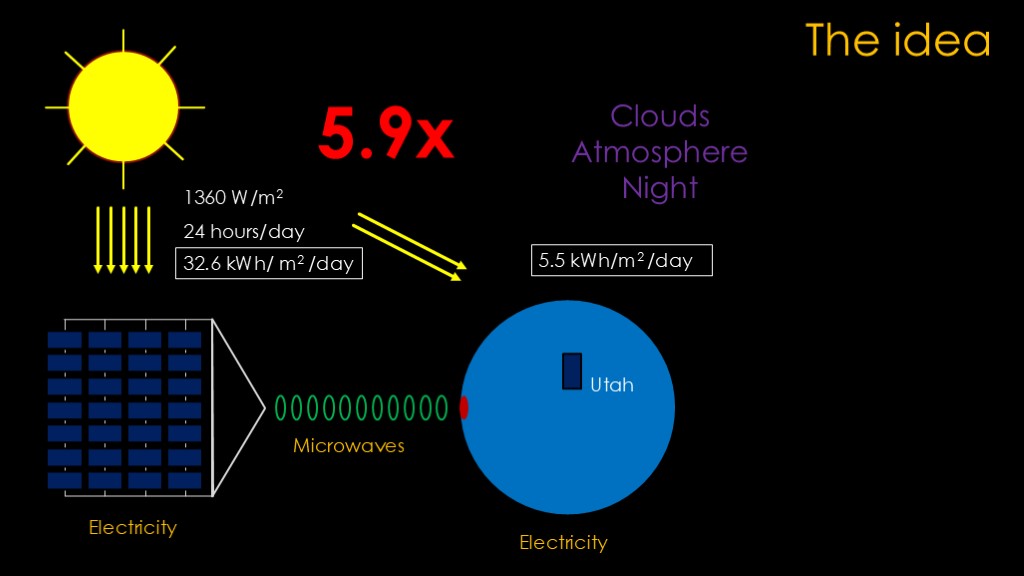
Here's the basic idea...
We build a big satellite out in geosynchronous orbit - 36,000 kilometers - so that it stays in the same place over the equator. That satellite has large arrays of solar cells that can convert the sun's light into electricity.
This is a good place for solar cells; in earth orbit there is 1360 watts of energy falling on each square meter of solar cell, and the sun shines 24 hours per day. Multiply those together, and that means we get 32.6 kilowatt hours of power for every square meter of solar cell each day.
Compare that to solar cells on the surface of the earth, in this case a solar farm in Utah. I chose Utah because it's quite sunny but not as sunny as New Mexico, so it's a reasonably average place in the American Southwest. We know that sunlight is blocked by clouds, we know that the atmosphere absorbs some of it, and obviously the sun doesn't shine at night. There is information from the National Laboratories that tells us the average amount of solar radiation per day in a given location. For Utah, it's about 5.5 kilowatt hours per square meter per day.
If we divide 32.6 by 5.5, we find that, over a year, a solar cell in geosynchronous orbit produces 5.9 times the power of one on the ground in Utah. That is the exciting part about solar power satellites, you get much more power from a given area of solar cells.
There is one problem - getting that electricity to the ground. That is done by converting the electricity to microwaves, and beaming - or aiming - those microwaves at a small spot on the earth, where we have placed a large antenna known as a rectenna. That converts the microwaves back into electricity.
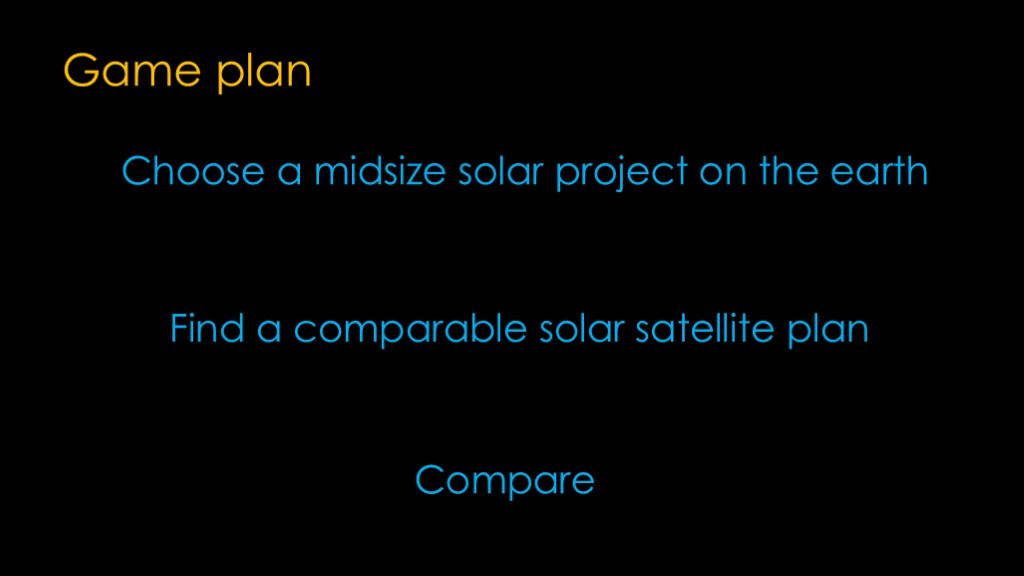
Not surprisingly, there are a ton of factors involved in comparing space-based and terrestrial solar projects, and I didn't want to make a thesis project out of it, so I came up with a simple game plan.
First, I'm going to choose a midsize solar project on the earth
Second, I'm going to find a solar power satellite that produces a comparable amount of power
Third, I'm going to compare the two options.
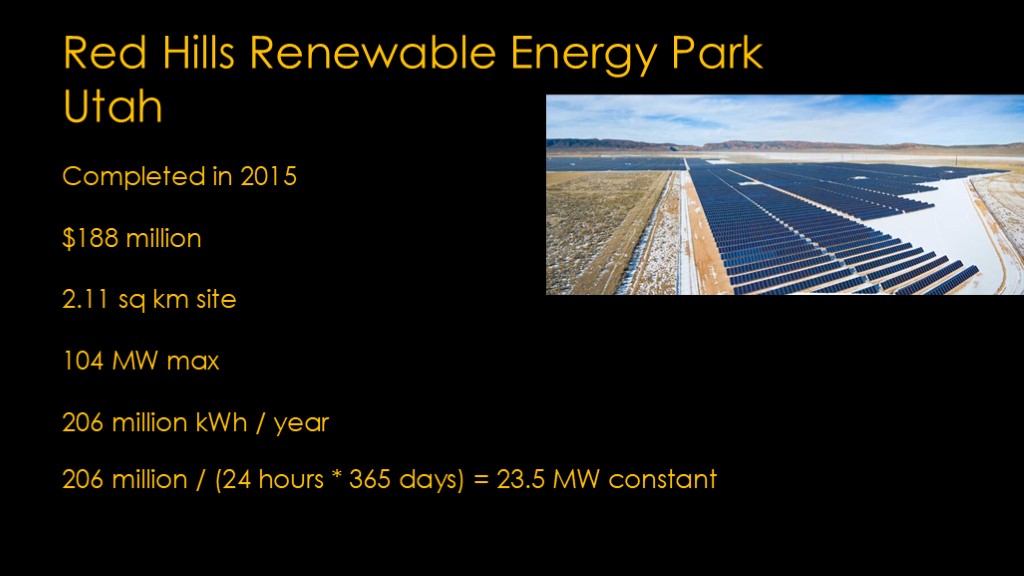
For the terrestrial option, I chose Red Hills renewable energy park in Utah.
It was completed in 2015 at a cost of $188 million, and covers 2.11 square kilometers of land.
It will generate 104 megawatts of power at full output and about 206 million kWh / year
If we divide that by the number of hours in a year, we will find that the average output is 23.5 megawatts. That is the size of solar satellite we are looking for.

Nicely, there's a study that aligns pretty well with the Red Hills renewable energy park. The SPS-ALPHA study, completed in 2012, has a pilot plant option that delivers 18 MW to earth, which will generate about 80% of the power that Red Hills will generate in a year.
This project looks at the full cost of such a project, and it estimates it will cost about $4.5 billion to complete, and over the 10 year lifetime it will be able to generate power for $3.26 per kilowatt hour.
https://ntrs.nasa.gov/api/citations/20190002466/downloads/20190002466.pdf
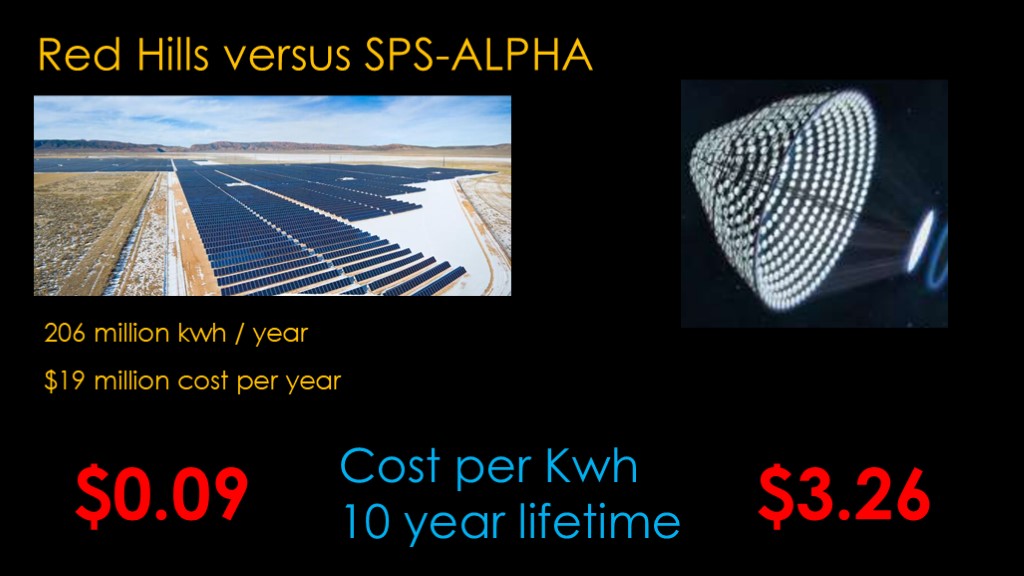
Red Hills makes 206 million kwh per year, and the construction cost allocated over 10 years gives a cost of $19 million per year. Do the math, and that comes out to 9 cents per kilowatt hour generated.
That's compared to $3.26 for SPS-ALPHA
But it's actually worse than that.
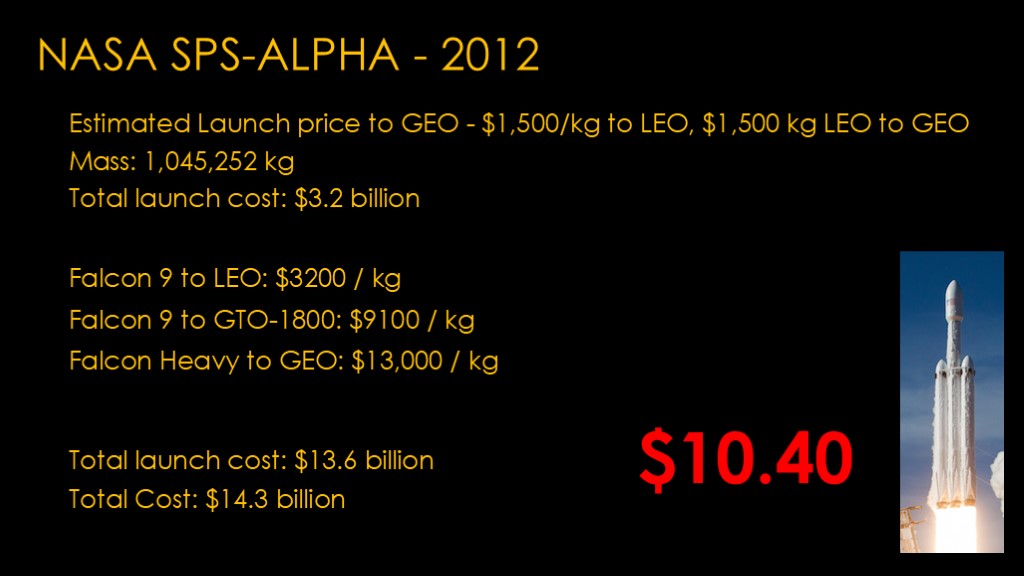
SPS-ALPHA estimates a launch cost of $1500/kg to get to LEO and $1500/kg to get from LEO to GEO, for $3000 per kilogram total.
The mass of this option is a little over a million kilograms, for a total launch cost of $3.2 billion
I have no idea what transportation system they were thinking of in 2012.
Falcon 9 to LEO on starlink missions is likely around $3200 / kg, but that's only to LEO.
Falcon 9 to GTO-1800 is probably around $9100 / kg, but you need to get from GTO to GEO
The only real option is Falcon Heavy, which will run around $13,000 / kg.
1 million kilograms at $13,000 per kilogram is a bit more than $13.6 billion, so the total cost is not $4.4 billion, it's $14.3 billion.
That pushes the per-kilowatt hour cost to $10.40.
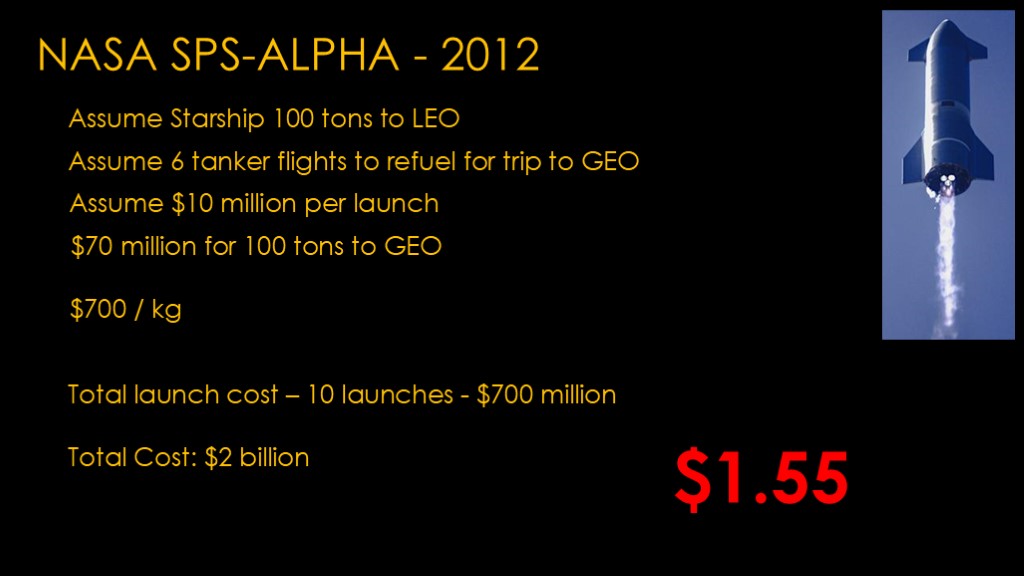
But what about starship?
Let's assume starship can take 100 tons to LEO and can be refueled in 6 tanker flights with enough propellant to get to GEO.
Assume $10 million per launch.
That means $70 million for 100 tons to GEO, or $700 / kg
That puts the launch cost at $700 million, the total cost at $2 billion, and the cost per kilowatt hour at $1.55, or 17 times.
Which actually is decent for a pilot project; the launch cost is significant but not killing us.
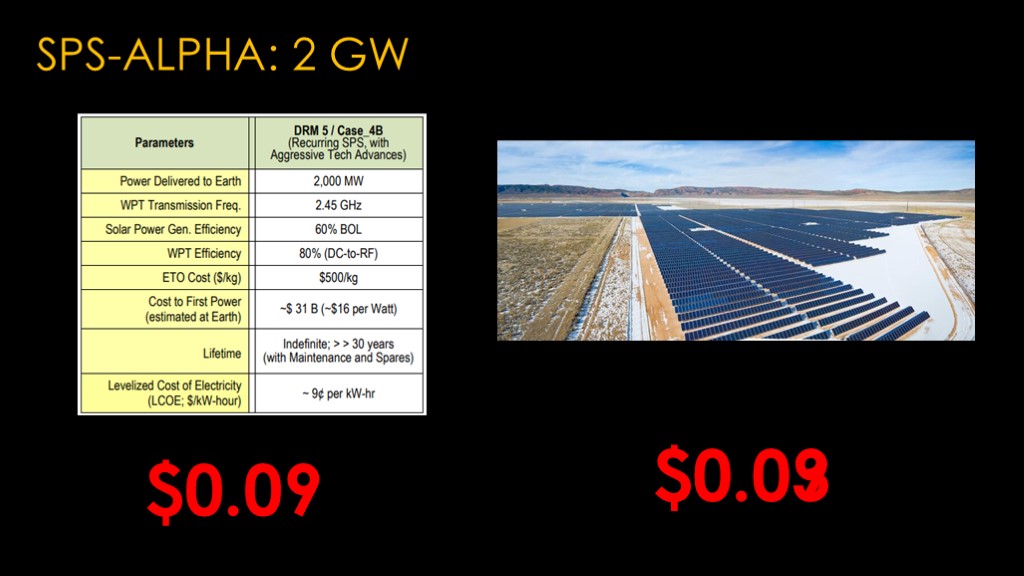
There is a production version of SPS-ALPHA that assumes 100 times more power, or about 2 gigawatts. It also assume much cheaper equipment and transportation costs of $1000/kg to GEO - around what starship might be able to do. And higher efficiencies in all of the electronics, and much cheaper prices for all the equipment because you are making a lot of them
Put all that together, and you get a cost per kilowatt hour of $0.09, the same as Red Hills.
That looks competitive.
Well, not quite. The $0.09 per kilowatt hour cost of red hills assumed a 10 year lifetime, but a 30 year lifetime is more appropriate, which means we're more likely to see $0.03 per kilowatt hour.

I am, of course, glossing over some important details that impact both cost and practicality.

We'll start by looking at issues with the terrestrial (land based) solar projects.
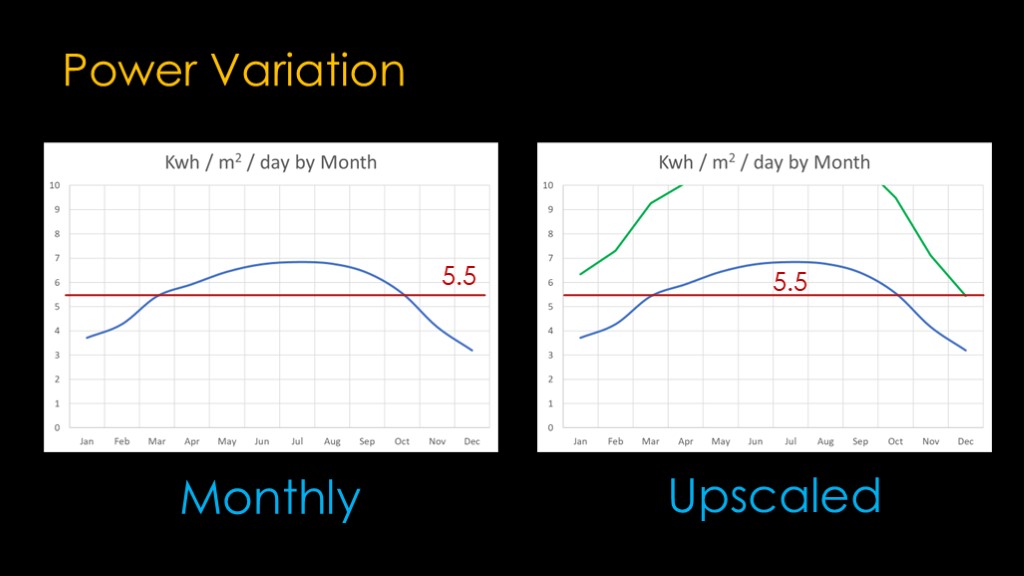
The power generated varies from month to month.
Here's a chart that shows the monthly variation of sunlight in Utah, with the red line showing the 5.5 kilowatt hours per square meter per day value that we were basing our comparison on. We can see in December that we are falling short of that amount of power.
While there are longer-term power storage approaches that might allow us to save power from one season to use it the next season, they aren't very well developed yet and they are expensive.
The simplest thing to do is to simply increase the size of the system by about 75%. The green line shows that at our lowest-power month, we are now at the amount of power we get from the satellite solution.
We now have a lot of excess power in the sunny summer months.
https://maps.nrel.gov/nsrdb-viewer/
https://www.solarenergylocal.com/states/utah/salt-lake-city/
https://books.google.com/books?id=ixJSAQAAMAAJ&pg=PA328&lpg=PA328&dq=salt+lake+city+solar+radiation+by+hour&source=bl&ots=RX7VpcQqv3&sig=ACfU3U3McZe0-kTMmvHvuxTfgrZF7OZLSg&hl=en&sa=X&ved=2ahUKEwjwhLmBwaX3AhXpKzQIHUo8DPkQ6AF6BAg5EAM#v=onepage&q=salt%20lake%20city%20solar%20radiation%20by%20hour&f=false
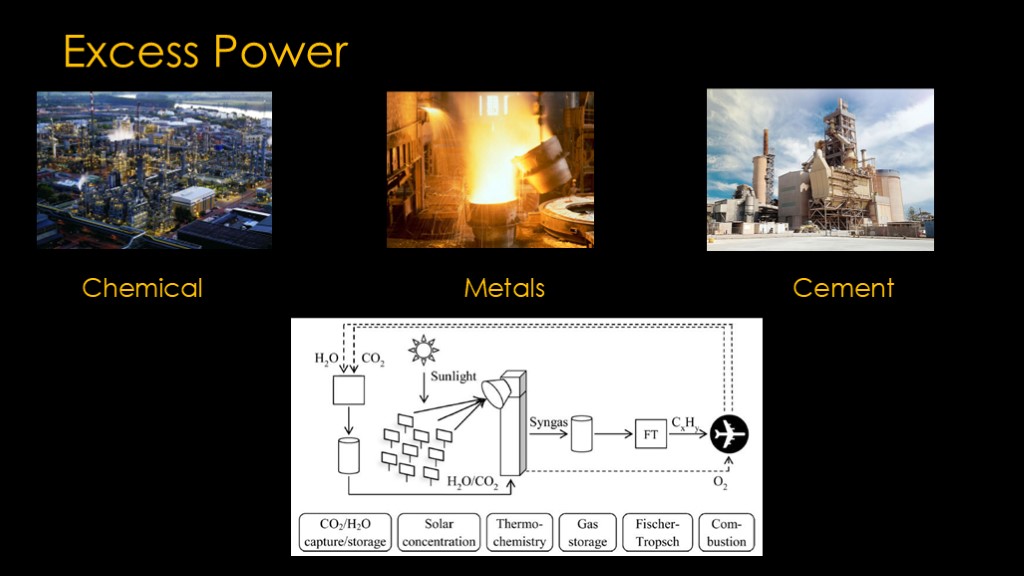
Excess power is an ongoing problem with renewable power.
One approach might be for the industries that use a lot of power - the chemical, metals, and cement industries, for example - to target their production at the times of the year when power was abundant and therefore much cheaper.
In particularly, jet fuel can be synthesized using water, carbon dioxide from the air, and power from the sun, and fuels could be stockpiled during the summer months for use during the winter months.
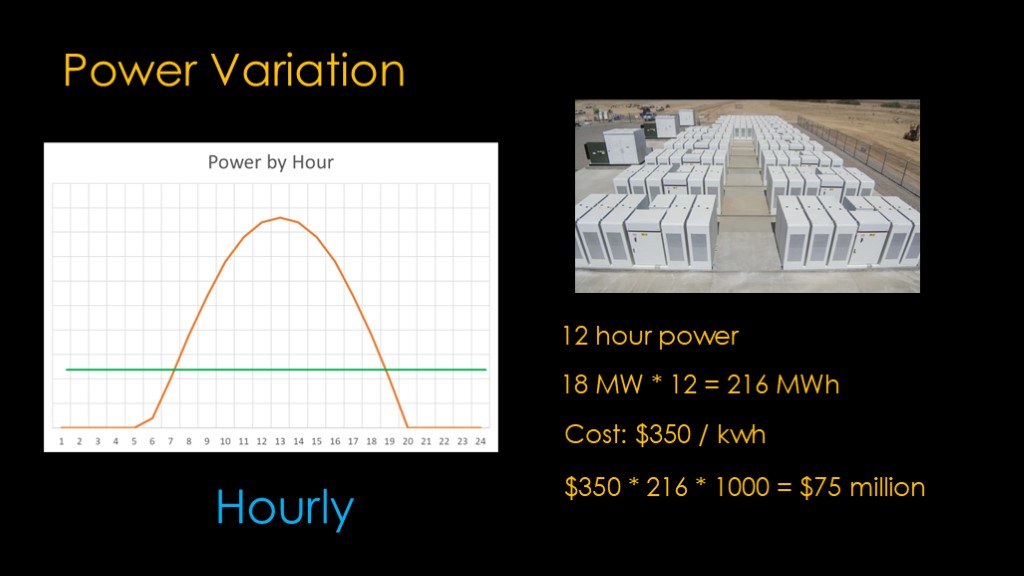
There are also hourly variations; here's some data from Utah that shows how the power varies by hour.
What we need is the ability to spread that out so that we can supply some of the power when the sun isn't shining, perhaps at the level of the green line. There are different technologies for this, but the most versatile one is battery storage.
12 hours worth of power at 18 megawatts is 216 megawatt hours.
The cost in 2020 of battery storage systems is about $350 per kilowatt hour, so adding batteries to support that 12 hour requirement is about $75 million.
At an installation like Red Hills, that increases the cost by about 40%.
https://www.pnnl.gov/sites/default/files/media/file/Final%20-%20ESGC%20Cost%20Performance%20Report%2012-11-2020.pdf
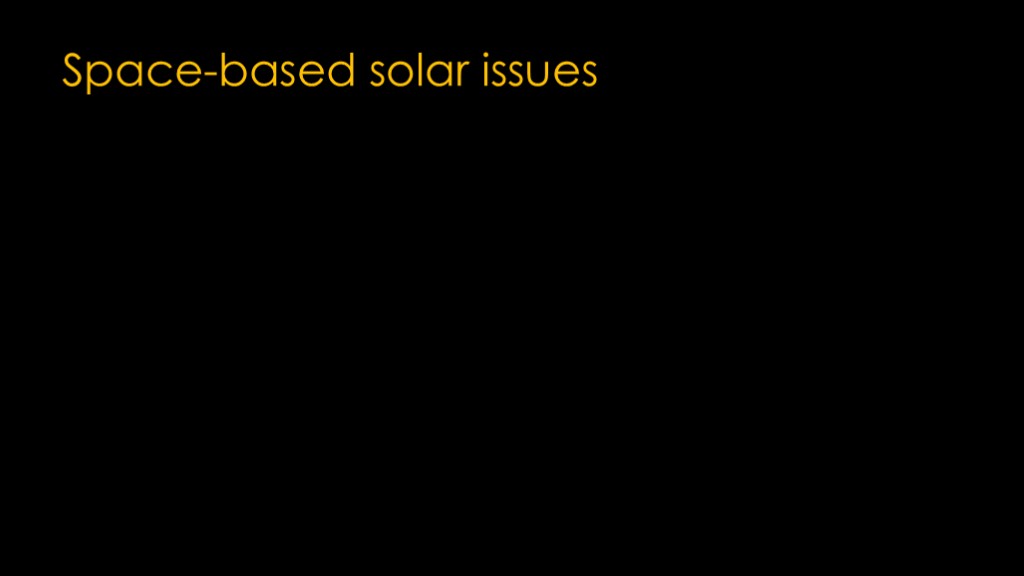
Onto the space based solar issues.

The effects of high-power microwave beams are not fully known.
They might interfere with satellites, either geosync satellites nearby or satellites in lower orbit.
They might impact aircraft
They might harm birds
And they might interfere with radio astronomy.
All of these would need more study.
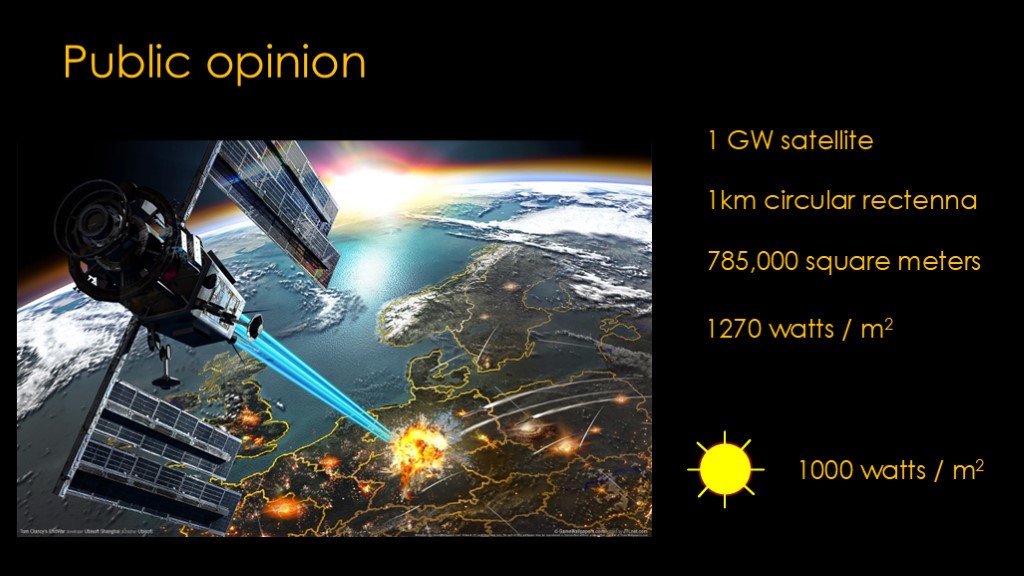
"Beaming microwaves to the ground" sounds a lot like "orbital death ray" to me...
In reality, microwaves can't be focused tightly enough to be a useful weapon.
Let's assume a satellite that puts out 1 gigawatt of microwaves. The rectenna for that will be at least 1 kilometer across, or 785,000 square meters. That gives is 1270 watts per square meter.
Our old friend the sun is around 1000 watts per square meter.
We can reduce the power density simply by increasing the size of the rectenna.
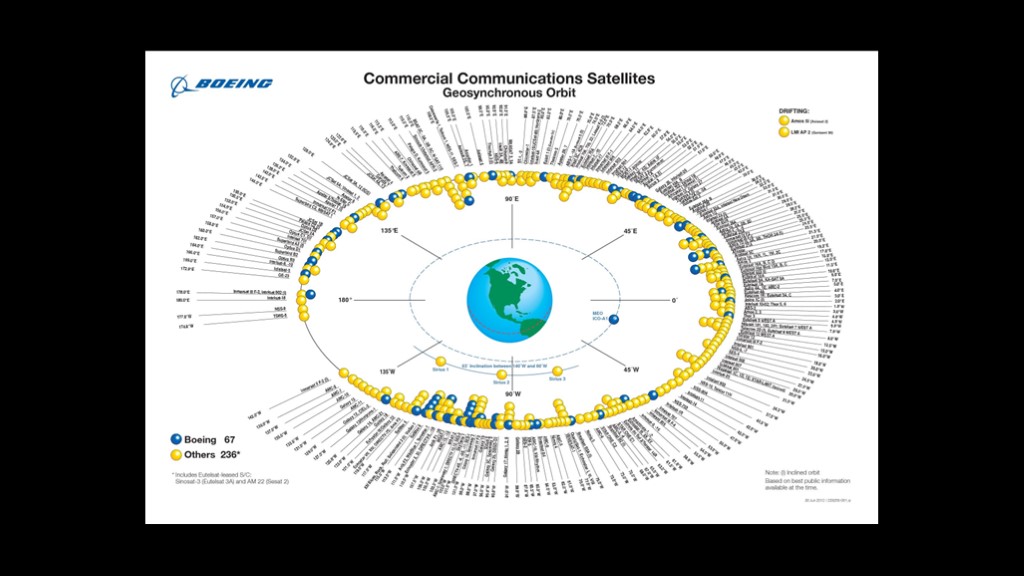
This picture shows a relatively current map of the satellites in gosynchronous orbit.
It looks quite crowded, but the geosynch space is quite big. Under international agreement, you can launch to a location if you can guarantee that you won't interfere with the current satellites; this is where the beam effects become very important. There also may be additional regulations for a specific country.
If you want to deploy solar power satellites, you will need to develop a workable international approach to do so.
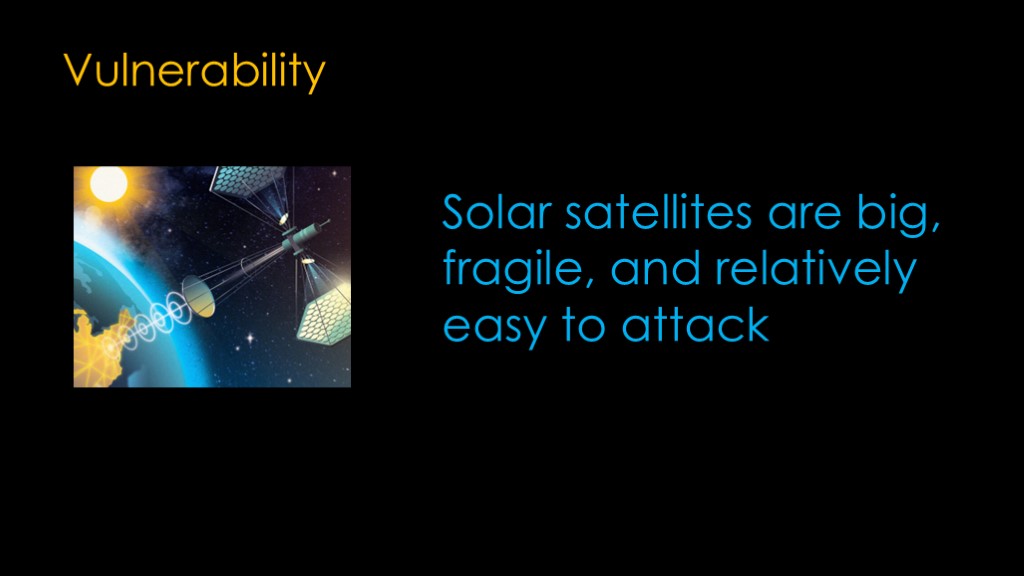

In summary, even with the rosiest assumptions, power from solar power satellites is around 3 times the cost of terrestrial solar power.
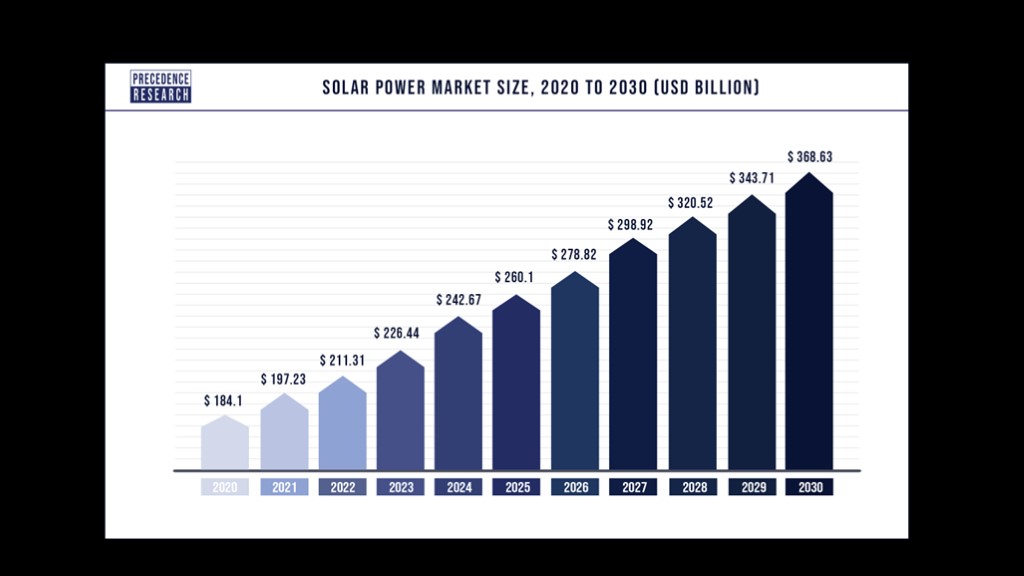
And it gets worse...
The solar industry is very hot, and there are thousands of companies competing in the production of everything that goes into a large-scale solar project - the panels, the electronics, the tracking machinery, the physical hardware, the construction process, etc.
Large scale terrestrial projects will continue to benefit from all of that innovation, while there aren't thousands of companies working on solar power satellites. They would benefit from the cheaper prices of solar cells, but most of the project cost comes from other things.
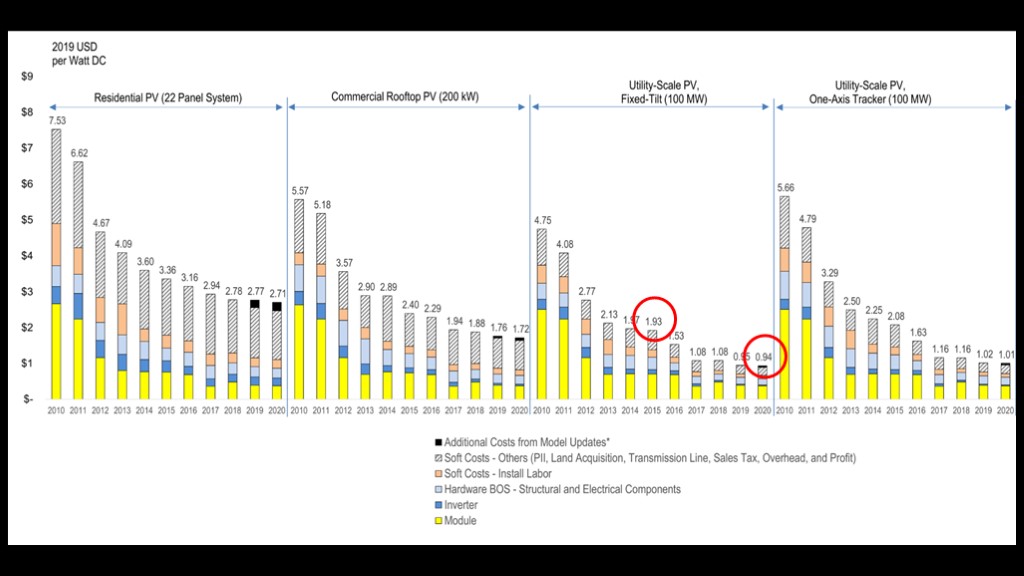
Here's a fun little chart from the US National Renewable Energy Laboratory that looks at project costs.
Red hills was completed in 2015, so we would expect that the cost would be about $1.93 per watt, which is pretty close to the $1.81 per watt that it cost.
Note what happens if you move ahead 5 years. The total cost goes down to $0.94 per watt, or less than half. So that $0.03 / kwh of power cost on a project like red hills will be cut roughly in half for the next project only 5 years later. This process will continue.
https://www.nrel.gov/docs/fy21osti/77324.pdf
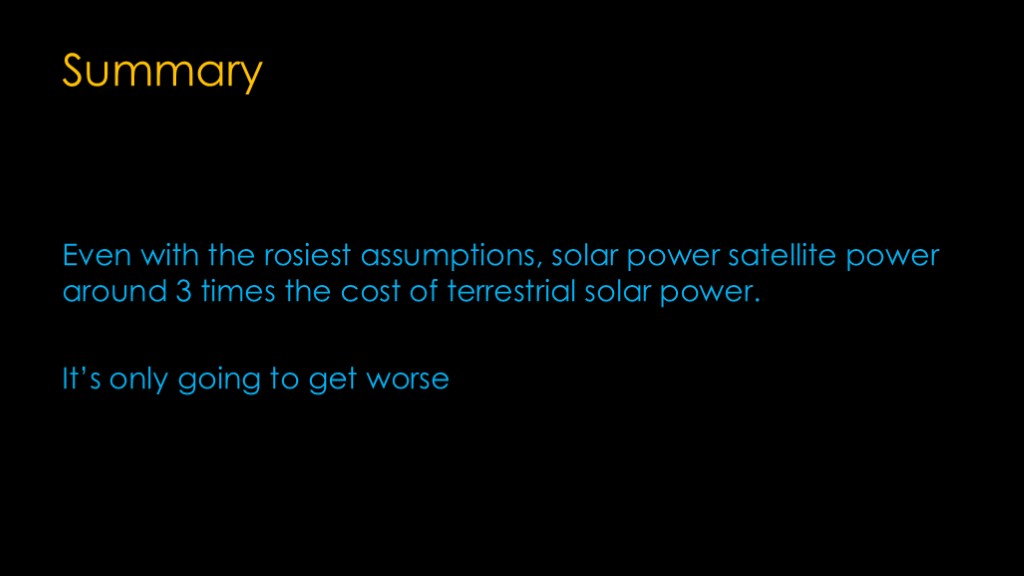
To complete the summary, it's only going to get worse as terrestrial projects get cheaper.

If you enjoyed this video, please carve a fish out of a carrot